Article body copy
Nestled in the heart of Philadelphia, Pennsylvania, the Academy of Natural Sciences of Drexel University emanates the aura of a sprawling cabinet of curiosities. Its neoclassical facade is covered in natural motifs—doorways flanked by ammonites, handrails that curl into ferns, bronze door handles shaped like ibis skulls. As the oldest natural science institution in the western hemisphere, the academy has accumulated a trove of remarkable specimens. Among the 19 million or so specimens housed here are plants procured on the Lewis and Clark Expedition, blue marlin reeled in by Ernest Hemingway, and America’s first mounted dinosaur skeleton.
Many of the academy’s most unassuming yet impactful treasures are filed away on its second floor, in an office space crowded with hulking cabinets and microscopes. Next to one of these microscopes, curator Marina Potapova pops open a notebook-sized plastic container brimming with glass slides. To the untrained eye, these unremarkable slides seem filthy—each looks like it’s been smudged by dirty fingers.
But as soon as Potapova slips one under a microscope lens, the slide’s contents dazzle. Dozens of diatoms—microscopic, single-celled algae encased in sturdy silica walls and found wherever there is water—are fixed to the slides in a myriad of shapes.
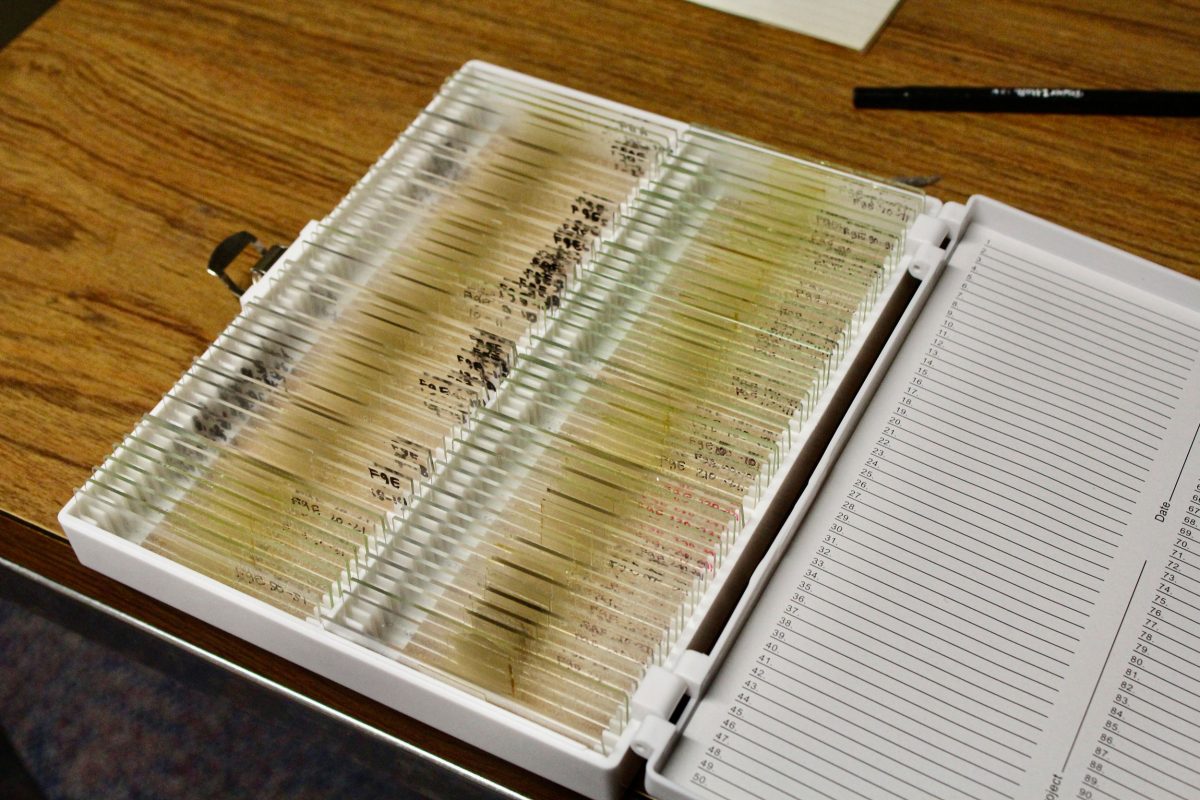
With over four million specimens, the Academy of Natural Sciences of Drexel University’s diatom collection in Philadelphia, Pennsylvania, is the second largest in the world. Photo by Jack Tamisiea
Some are elongated like baguettes or flattened into saucers while others hook together to resemble translucent centipedes. Others are barbed like harpoons or shaped like pudgy sea stars. Some even resemble ornate stained-glass windows. Under a microscope, a few drops of murky pond water become a kaleidoscope of diatom diversity.
The beauty of diatoms is impressive. But their ecological significance is staggering. Diatoms anchor marine food webs by feeding everything from minuscule zooplankton to mammoth filter feeders. (Case in point: scientists have deduced that the rise of whales some 30 million years ago mirrors a spike in diatom diversity.) Diatoms also have an outsized atmospheric impact. As one of the planet’s most prolific organisms, diatoms siphon harmful gases like carbon dioxide out of the air and produce massive stores of oxygen as they photosynthesize. It is estimated that roughly one-quarter of the air we breathe is created by diatoms.
More than four million specimens of these essential algae are plastered onto hundreds of thousands of slides and housed in the academy’s diatom herbarium. Only London’s Natural History Museum stores more slides of diatoms.
Although the academy’s diatoms no longer feed the planktonic masses or pump oxygen into the atmosphere, they do hold clues about how the aquatic world is changing. As their tough shells sink to the bottom of a body of water, they are stored in the sediment for millennia. When researchers use a sediment core to drill down into the muddy bottom of an estuary, they are collecting diatoms deposited over the eons.
In addition to being plentiful and hardy, diatoms are also a crucial barometer for a variety of environmental conditions. The existence of certain diatom species can help scientists pinpoint everything from industrial pollution to oxygen depletion. Potapova and her colleagues have recently used these water condition time capsules to gauge how accelerating sea level rise is endangering New Jersey’s coastal wetlands.
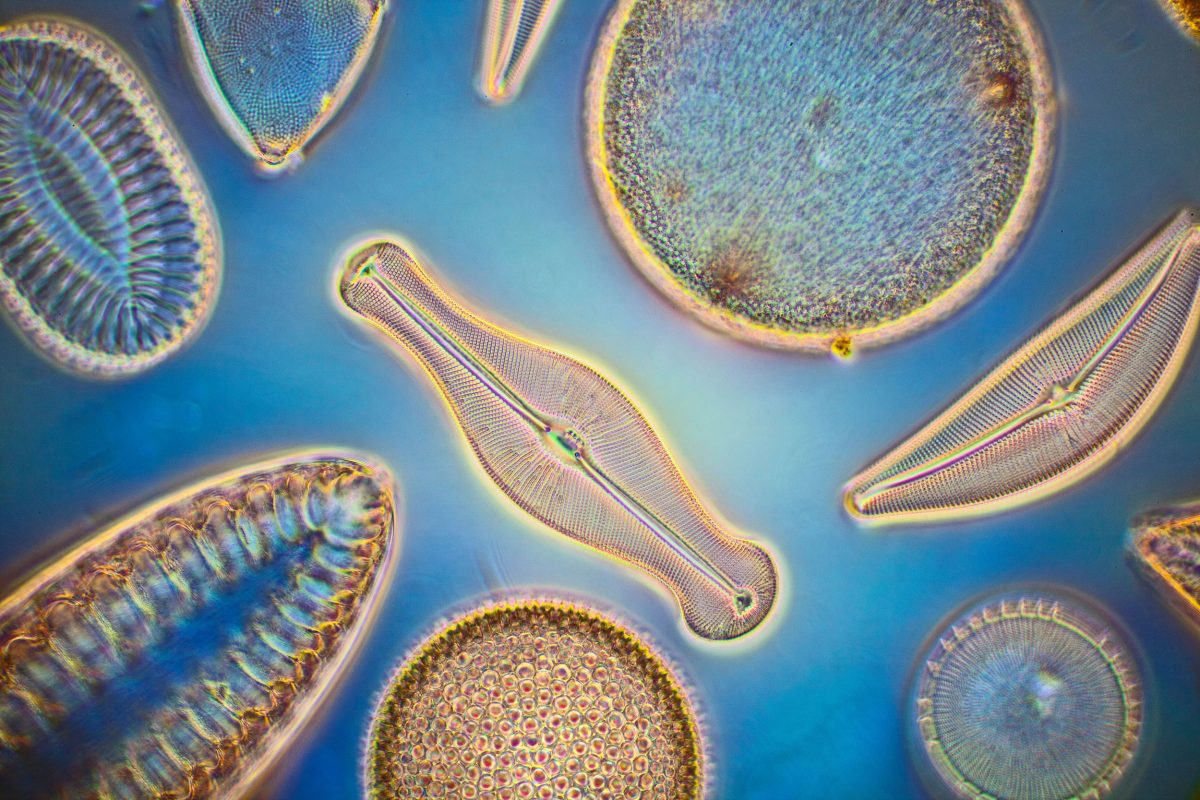
Diatoms, a type of phytoplankton made of silica and coming in myriad shapes and forms, underpin marine food webs and have an outsized impact on the health of Earth’s atmosphere. Photo by Scenics & Science/Alamy Stock Photo
Thanks to a relative dearth of environmental monitoring, the historical decline of these crucial marshes—which hoard carbon, provide nursery grounds for fish, and buffer the coast from storms—has largely been obscured, making restoration efforts little more than guesswork.
However, the millions of diatoms stored at the academy are helping the researchers track the fall of the coastal wetlands as the ocean rises, which may help anticipate the coast’s future. “Diatoms are absolutely invaluable environmental archives,” Potapova says. “You can infer the future from what they tell you about the past.”
Considering the academy’s history, it is no wonder that the storied institution has become a hub for diatoms. With the advent of accessible microscopy in the 1850s, many of Philadelphia’s gentleman naturalists were captivated by the realm of minute microbes, eventually establishing the Microscopical Society of Philadelphia at the academy.
Because of their striking beauty, diatoms took the microscopical society by storm. To satiate their interest, many of these diatomists headed east to the New Jersey coastline to collect samples, which they mounted onto glass slides using a steady hand and a brush brimming with pig eyelashes. The hobbyists would then gather at the academy to show off their slides at gourmet luncheons.
The academy’s early members were clearly enthusiastic about diatoms, but most were amateurs and published little research on the myriad of specimens they collected. Organizing the mountains of slides compiled by each collector into a cohesive collection proved to be quite the task for Ruth Patrick when she arrived at the academy in 1933. The daughter of an amateur diatomist who received her first microscope at the age of seven, Patrick gravitated toward diatoms early in her childhood and eventually completed her PhD studying the microscopic organisms. Despite her scientific credentials, she was relegated to setting up microscopes and slides for the untrained hobbyists. It took her years to even gain membership in the male-dominated academy. But her persistence paid off, and in 1937 she became curator of the nascent diatom herbarium.
Patrick’s first goal was organizing the amalgamation of different collections into a unified and comprehensive source for taxonomic research. When she was not mounting and organizing slides, she was wading into nearby ponds and streams to collect new specimens in the field, where she gradually gained an appreciation for the ecological importance of diatoms.
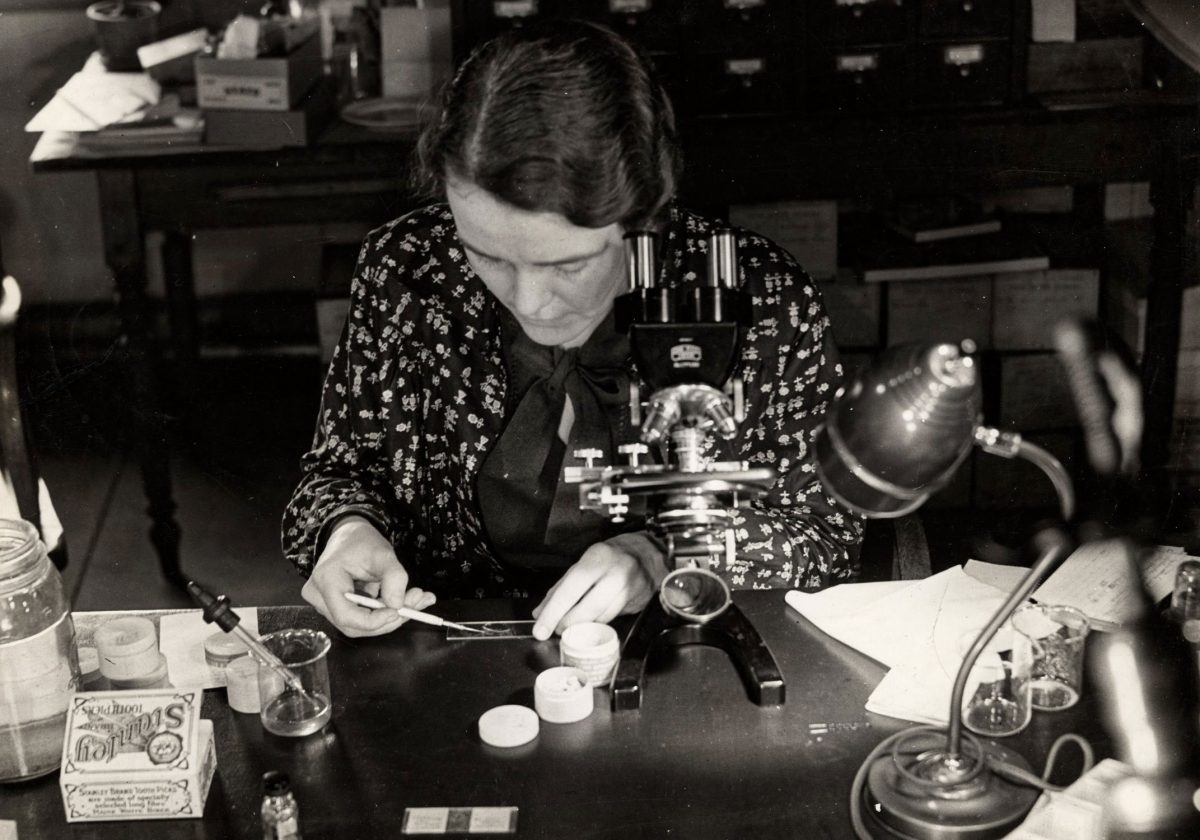
Ruth Patrick, the first curator of the academy’s diatoms, works on the collection in the 1940s. Photo courtesy of Academy of Natural Sciences Archives coll. 457
This crystalized during a 1948 expedition to Pennsylvania’s Conestoga River—a body of water heavily polluted by sewage and industrial runoff. As her team collected samples from throughout the creek, she recognized patterns in the diatom composition. Some species’ densities exploded in areas contaminated with sewage, while others thrived in spots tainted with chemicals. Soon, Patrick became adept at using the existence of certain diatoms as a key for diagnosing pollution in lakes and rivers. This supported the idea that greater diatom diversity correlated with healthier freshwater ecosystems—an insight ecologists coined the Patrick Principle.
Patrick revolutionized the use of diatoms to monitor freshwater systems, but using them in coastal wetlands lagged behind. The brackish fusion of fresh and salt water in coastal zones such as estuaries creates habitats that are dynamic and complex with a mixture of inland and oceanic diatoms, according to Mihaela Enache, a research scientist at the New Jersey Department of Environmental Protection (NJDEP).
However, in recent decades, the sea has dominated the once-dynamic coastal margin, propelling farther inland as sea levels rise. Over the last century, the sea level along New Jersey has risen by 0.45 meters, more than double the global average of 0.18 meters. By 2100, the sea could rise by over a meter.
This dramatic rise in sea level has proven disastrous for the patchwork of marshes along New Jersey’s coastline, several of which have already succumbed to the sea. However, the full extent of the loss of these wetlands is difficult to parse because environmental monitoring only dates back a few decades.
Without a sense of a wetland’s natural conditions, ecological restoration is daunting. Having that information is crucial, says Enache. “Without [it], you are in the dark.” Thankfully, some of this missing data is recorded in the academy’s cache of diatoms.
Like most coastal margins, New Jersey is familiar with sea level rise. During the Pleistocene, when New Jersey was blanketed by ice and home to mastodons, sea ice slurped up stores of seawater. Around 18,000 years ago, sea levels sank more than 130 meters below their current levels—extending the New Jersey coastline 110 kilometers farther into the Atlantic Ocean.
The end of the last ice age sparked a steady climb in sea levels. Retreating ice sheets caused parts of New Jersey to sink. This subsidence, combined with glacial melt, proved a potent mix for rapid sea level rise according to Jennifer Walker, a sea level researcher at Rutgers University.
In a study published last year, Walker turned to the past to put New Jersey’s current bout of sea level rise in context. “If we can understand how temperatures, atmosphere, and sea level changes are all interconnected in the past, that’s what we can use to project changes in the future.”
To gauge fluctuating sea levels over the past 2,000 years, her team examined the shells of single-celled protists called foraminifera that are finely calibrated to specific environmental conditions. This makes them a valuable proxy for reconstructing shifts in sea levels. By identifying the presence of certain foraminifera species throughout sediment cores collected from different spots along the Jersey shore, her team concluded that New Jersey’s coast is experiencing the fastest rise of sea level in 2,000 years.
The NJDEP hoped diatoms could serve as a similar tool for understanding how coastal marshes responded to the rising sea. Like foraminifera, each diatom species is extremely sensitive to environmental conditions. For example, species like the rolling pin–shaped Nitzschia microcephala thrive in nitrogen-rich environments, making their shells a common sign of nutrient pollution. Other species, like Diploneis smithii, whose segmented shell resembles a slender trilobite, prefer saline waters. Their existence inland is a good indication of past sea level intrusion and helps researchers deduce which marshes have been prone to flooding in the past.
To pinpoint where these microscopic indicators once existed, the NJDEP deployed a team of researchers into several marshes along the coastline, ranging from heavily polluted wetlands in the north to near-pristine tidal marshes in the south. At each site, they cored into the marsh muck, sampling as deep as two meters in certain spots. Enache compares this method to slicing into a stack of pancakes—as you cut deeper, you are essentially going back in time from the steaming pancake just off the griddle to the soggy pancake deposited at the bottom of the stack. As they dug deeper, the researchers were traveling back decades. In total, they collected nine cores from five wetlands.
The NJDEP then sent the sediment cores to Philadelphia, where Potapova and her master’s student Nina Desianti gauged the diatom diversity of New Jersey’s coastal wetlands through time. Desianti began processing the diatom specimens by soaking the sediment samples in strong acid to dissolve everything but the silica shell before adhering them to slides. The result was an environmental history of each of the five marshes mounted onto thousands of glass slides. Then, by using the specimens already cataloged at the academy, they played a microscopic game of who’s who. But even the sprawling diatom herbarium lacked all the answers—Desianti estimates that over one-third of the 900-odd species they collected from the wetlands are new to science.
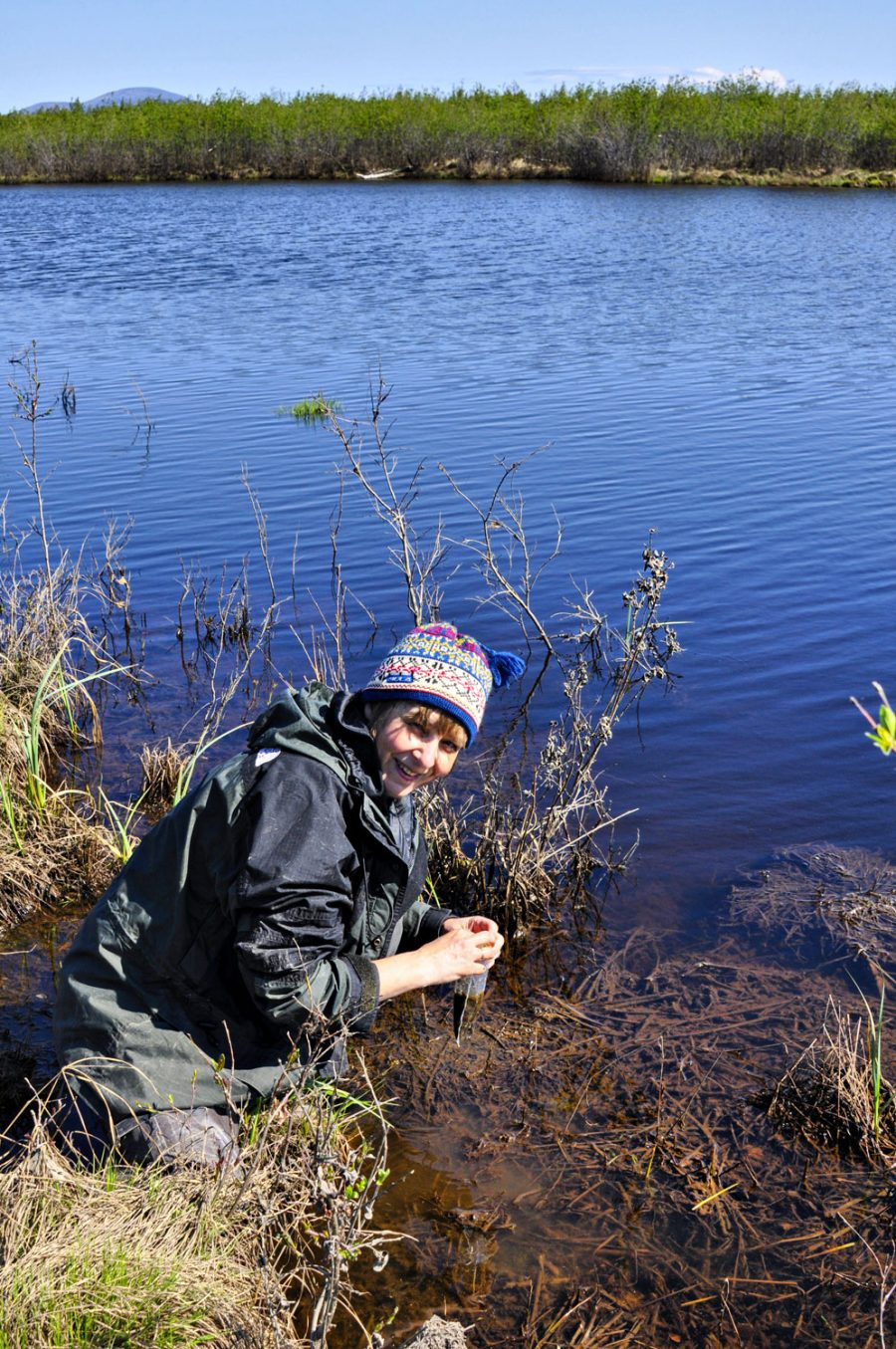
Marina Potapova, curator at the Academy of Natural Sciences of Drexel University, samples for diatoms. Photo courtesy of Academy of Natural Sciences of Drexel University
The monumental effort yielded the tome Diatom Flora of the New Jersey Coastal Wetlands in 2019. To the uninitiated, it is an overwhelming mix of intimidating Latinized names and dramatic electron microscope photographs that portray the diatoms in all their infinitesimal glory. To Enache, it’s the key to decoding the decline of New Jersey’s wetlands. By punching the composition of diatom species and modern wetland conditions into modeling programs, Enache is able to illustrate what a wetland once looked like. “Diatom species are a very precious environmental archive because we can go back in time—when nobody could take measurements of nutrients, nobody could take measurements of pH—and actually use the diatom species to get complete numbers,” she says. These figures help her record the increase of everything from agricultural nutrients to industrial chemicals in New Jersey’s water all the way back to the mid-1600s, when Europeans arrived and began to dramatically alter the state.
But while diatoms offer a window into the decline of New Jersey’s marshes, they also offer a glimpse of environmental resiliency to Desianti. Just as the team used the salt tolerance of different diatoms to map past episodes of sea level rise, they could also use the microscopic algae to deduce how these marshes responded to saltwater intrusion.
When it comes to habitats, marshes are particularly dynamic. As the boggy barriers between land and sea, coastal marshes hoard sediment, building vertically to stay above the rising ocean. When sea level rise outpaces their accumulation of sediment, the marshes retreat inland by spilling into coastal forests. As the marsh’s briny water percolates into the groundwater, it kills the trees, creating what ecologists call “ghost forests” of desiccated tree husks.
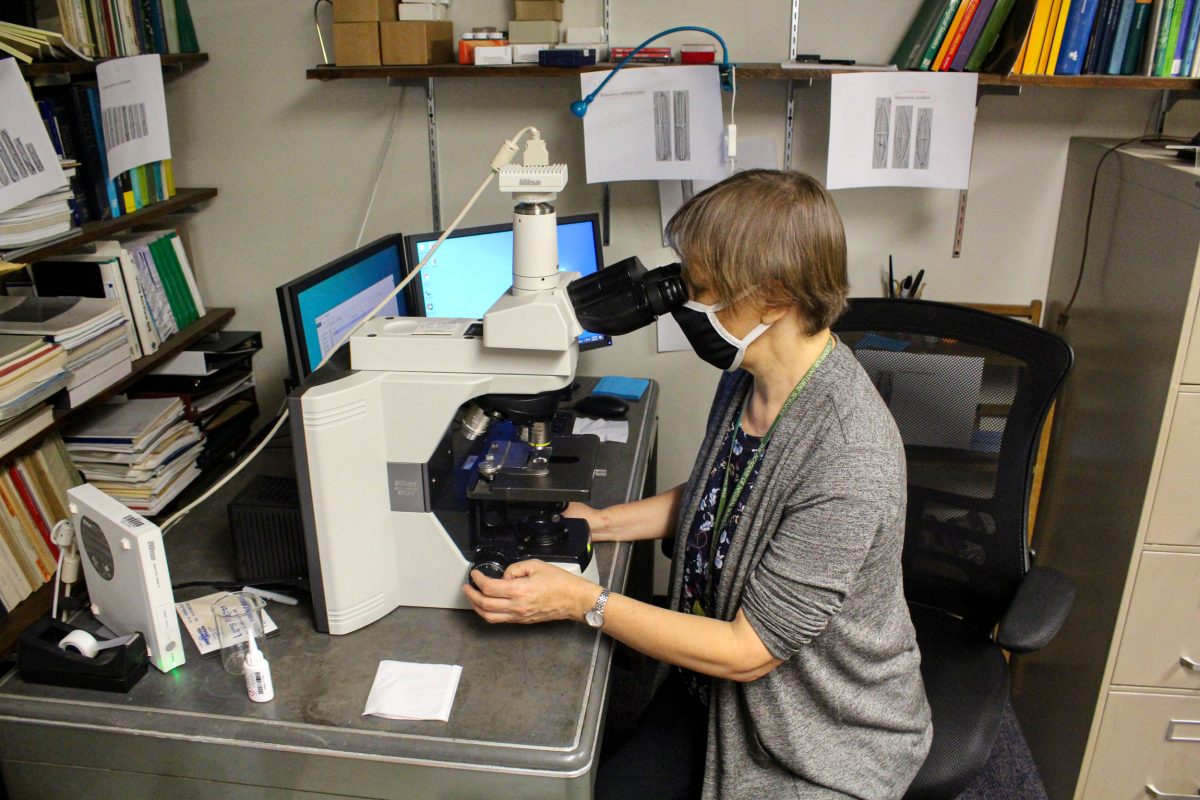
Potapova examines diatoms sampled from the coast in an Academy of Natural Sciences of Drexel University lab. Photo by Jack Tamisiea
While coastal marshes are naturally pliable, anthropogenic impacts have rendered them brittle. In New Jersey, dams strain out sediment, robbing the marsh of construction material, and retreating marshes butt up against paved roads and vacation homes. “Salt marshes have to compete with us in establishing habitat,” says Desianti, who now uses diatoms to track nutrient pollution for the Wisconsin State Laboratory of Hygiene. “As a result, these salt marshes are squeezed between sea level rise and human pressures.”
The diatoms Potapova and Desianti collected and identified will help the NJDEP not only understand how New Jersey’s coastal wetlands have responded to past bouts of sea level rise but also inform what can be done to restore these vibrant ecosystems.
The deeper you core into the pond muck, the more diverse the diatoms tend to be, which, as Ruth Patrick deduced decades ago, is the trademark of a healthy ecosystem. As you examine a core’s more recent chapters, this diatomic diversity often decreases as certain specialists, like salt-loving marine diatoms, dominate. Understanding where these saline-specializing species persist reveals which ecosystems have succumbed to sea level rise and where restoration efforts, like an influx of sediment, are needed the most.
Diatoms are not a cure for threats like sea level rise and pollution. Instead, they are a key to help combat them. They reveal what pristine habitats were once like long before anyone paid attention and illustrate what has gone awry over the centuries. To enact successful wetland restoration measures, it would be wise to consult these microscopic algae.
Which is why the diatom specimens Potapova and Desianti collected in New Jersey’s coastal marshes are being filed away alongside Patrick’s specimens in the diatom herbarium’s steel cabinets. Similarly to how they persist in sediment for millennia, the diatom specimens stored at the academy will offer invaluable data points for future researchers to make sense of pollution and shifting sea levels.
“The diatom herbarium is an invaluable resource for diatom research,” says Desianti. “I’m sure that in the future, even when I’m gone, people will still access this collection and continue to investigate environmental issues.” She is confident that within the tens of thousands of slides deposited in the recesses of the academy are environmental breakthroughs waiting to be decoded.
https://news.google.com/__i/rss/rd/articles/CBMiXWh0dHBzOi8vaGFrYWltYWdhemluZS5jb20vZmVhdHVyZXMvcGhpbGFkZXBoaWFzLWRpYXRvbS1hcmNoaXZlLWlzLWEtd2F5LXdheS13YXktYmFjay1tYWNoaW5lL9IBAA?oc=5
2022-09-20 07:08:43Z
CBMiXWh0dHBzOi8vaGFrYWltYWdhemluZS5jb20vZmVhdHVyZXMvcGhpbGFkZXBoaWFzLWRpYXRvbS1hcmNoaXZlLWlzLWEtd2F5LXdheS13YXktYmFjay1tYWNoaW5lL9IBAA
Tidak ada komentar:
Posting Komentar